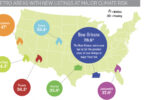Renting on the Rise for Americans
The Joint Center For Housing Studies of Harvard University (JCHS) recently released an in-depth, decade-long (20052015) study on the United States housing rental market, Americas Rental Housing: Expanding Options for Diverse and Growing Demand. The study shows an increase of all types of renters across the board shortly after the housing peak of 2004 and the housing bubble burst in the following years. Lack of income, affordability, financial risk and millennials who are apprehensive to settle down are just a few of the trends that have fueled the number of renters in all age, income and household categories.
Although renters under 30 account for the largest single share of renters, households over age 40 now account for the majority of renters. The largest increase in renters among the different age groups from 2005 to 2015 were renters in their 50s and 60s, with a 4.3 million increase.
It is no surprise that those earning under $25,000 annually make up the highest share of renters: This group has increased by 4.0 million from 2005 to 2015. However, the data indicates that those earning at least $50,000 annually (3.3 million increase) and those earning $100,000 annually (1.6 million increase) are not far behind.
The most common renter household type, single people living alone, have accounted for 2.9 million new renters since 2005. Despite the popular belief that the second most common renter housing type are young unrelated adults living together, the study finds that families with children are the second most common, rising by 2.2 million in the past 10 years.
It is clear that renting is on the rise for all types of American households. The construction of multifamily housing and conversions of single-family homes to rentals has not been able to keep up with the rising demand for rentals. Consequently, the cost of rent has increased as renters are still trying to gain financial ground. Meeting this demand for housing with a wide range of affordable options is the issue our industry is faced with, the study finds.







